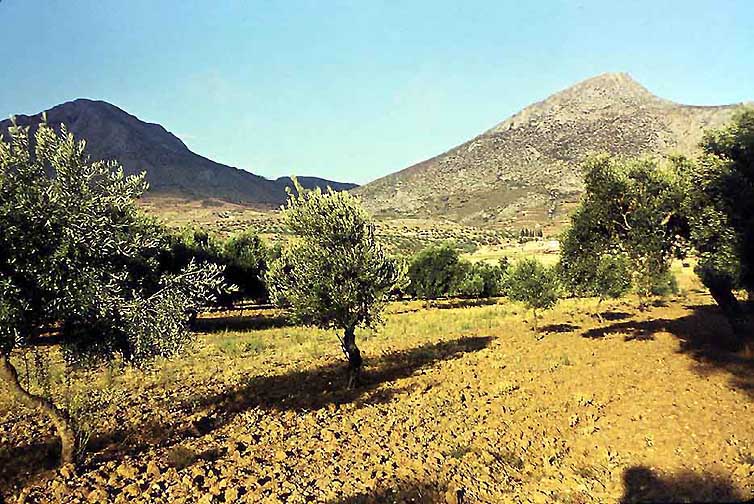
|
Argolis and Korinthos |
(800 kBy)Map of the Argolis
.
Mykene
|
|
In 1953 my brother Gerhard and I walked to Mykene for the first time. After a whole day on foot we arrived from Nauplia in this glorious light. The acropolis of Mykene is hard to see from the Argolid below, it is completely overwhelmed by the pair of mammarian "mountains" sacred to the Great Goddess, whose priestess was the queen of Mykene. If one knows, it lies just below the shadow on Mt. Zakas. (1953)
.
|
|
In 1985 Cornelius and I returned and spent an equally unforgotten evening on the hill which harbors the great bee-hive graves. From there one can see the citadel on its hill and the crack of the Goddess' chasm. The Palace of Mykene was built around 1200 BC - but there are parts that go back to the 17th century BC. (1985)
.
|
|
Schliemann found these gold masks in the graves of the Atrides, and declared them the death-masks of Agamemnon and his men, who were murdered by Kleitaimnestra, Agamemnons wife and Queen, and Aighistos her "lover" when Agamemnon returned home from Troy. They are now in the National Archeological Museum in Athens.
|
|
.
|
|
Barbara writing a letter. (1991)
.
|
|
Barbara under the mountain of the Goddess on the highest stones of the palace. To my horror, right below her is the bath where Agamemnon was ritually dismembered.....
.
|
|
Evening view from the citadel on the Argolid and the mountains of the northern Peleponnissos. (1991)
.
.
The Argolid Heraion
|
|
Only fifteen kilometers south along the mountains are the ruins of tht two temples of the Aergilid Heraion. This sanctuary together with the Heraion Akraia further north are two of the oldest sanctuaries in Greece. (1991)
.
|
|
The foundations of the second Hera temple and the view of the Argolis. The trown of Argos is at the foot of the conical hill left of center. (1991)
.
Tiryns
|
|
The hill of Tiryns rises from the fertile plain very close to Nauplia. It was built by Cyclops 800 years before Mykene. Heraklas was born here around 2100 BC. This is the entry gate to the lower castle. Much of Tyrins was first excavated by Wilhelm Dörpfeld, one of Barbara's grand-uncles (on the Friedrich side). (1953)
.
|
|
View of the Bay of Argos from the top of Tiryns. The island of Vroutsi is seen to the left. (1953)
..
|
|
Resting in the shade of one of the emergency exits from the castle. (1991)
.
.
.Nauplia
|
|
The Venitian island of Vroutsi in the harbor of Nauplia and the mountains of the Peleponnisos. Argus is marked by its conical hill. (1953)
Epidauros
|
|
Epidauros, the original Asklepios sanctury, boast the largest and most beautiful theater in the Greek world and one of its earliest: 3rd cent BC - Only the theater at Thorikos in Attika is older.
.
|
|
Stage entrance of the theater.
Korinthos
|
|
The city of Nea Korinth (by the sea) and the block of Akro-Korinthos in the distance. Old Korinth, Palea Korinthos spreads at it's foot. This picture was the first I took of Greece, one very early August morning from the boat from Brindisi to Athens. We were waiting to pass the Korinthian Canal.
|
|
The ruins of Palea Korinthos date mostly from the Roman period (1st - 3rd cent AD) with. the Apostle Paul its best-known celebrity (his prison, the theater, his church etc etc). Except for the columns of the ancient Apollo Temple (6th century BC).
Akro-Korinthos
|
|
More rewarding is a climb to Akro-Korinthos with its immense Greek-Franco-Venitian-Turkish Fortress. These are the outer-most walls of the castle. On top are the foundations of an Artemis-Aphrodite temple with a stupenous view of the Isthmus, the "two" Seas, and the mountains of the Peleponnissos
.
.Heraion Akraia - Perakhora
|
|
The Heraion Akraia is almost forgotten, at the western promontory of the Geranium peninsula. It is close to the village of Perakhora and is often named after it. The pilgrims to this 8th-century BC sanctuary arrived by boat in this lovely harbor from axcross the Gulf of Korinth. There were two small temples to Hera above which toweres this, as the Tibetans would say "rungchung" : natural - not-man-made meaningful array of rocks : the two breasts and the head of the Great Goddess between them. There is also a deep cleft with a spring and a cistern between them. - Examples like this in Greece - not to mention Tibet - can soon convince one that such an interpretation - originally Vincent Scully's idiosyncratic idea - of the oldest sites is not at all fanciful.
|
|
The foundations of the temples and a stoa in the distance.
.